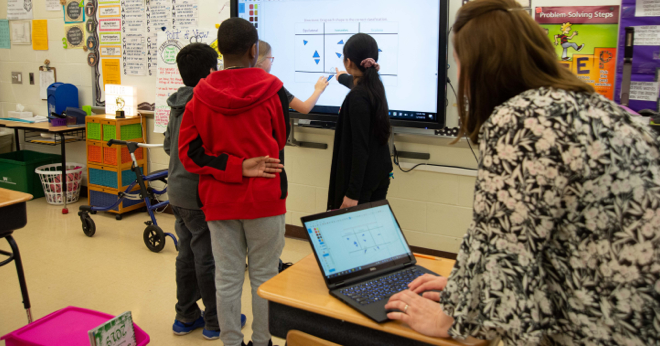Screen sharing is the process that allows you to show your exact desktop, laptop, phone, or tablet screen (or an application window of the screen) on screens in the same room or other locations. In education, it’s most commonly used to share the teacher’s screen with the big screen at the front of the room. This could be to share a lesson, a video, a website, or an application. Students are also able to share their screens when called upon.
We take a look at some of the benefits for both teachers and students below:
1. Enables hybrid learning – students don’t need to be in the same room as the teacher to share their screen. This is great for allowing hybrid and remote students to share their work back with the class, keeping them involved in the lesson.
2. Better engagement – Students are more motivated to stay on task when they know they may be called on to share their screen.
3. More mobility – wireless screen sharing means you can teach from anywhere in the room, allowing you to stay connected to your students.
4. Saves time – Screen sharing is quicker than waiting for students to write their work out on the board, saving precious teaching time. It also reduces the equipment set-up time at the start of class.
5. Encourages all students to contribute – Quiet students, who may not usually volunteer to go to the board to work out a problem on the whiteboard, may appreciate this less intimidating chance to share.
6. Builds students’ confidence – Students often worry that they’re “not doing it right” when it comes to working out problems. Seeing other students’ work in this controlled situation can alleviate their anxiety and build confidence in their abilities.
7. Improves digital literacy – having your students create and share content via their devices makes them familiar with the process of creating and sharing content with an audience – something which they will encounter in further education and future jobs.
8. Reduces anxiety around presenting – Students can test previews of their own slides (check for readability, colour, etc.) before presenting for a grade.
9. Less technical issues – anyone with any type of device can share their content. This is great for classrooms where students are working from different devices.
10. More student-centred classroom – creating a classroom where students can easily contribute and share their ideas on the big screen makes the classroom a more dynamic and equitable place.
This was originally published by DisplayNote, available here.
